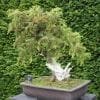Everything about a bonsai garden is done with a very particular sense of thoughtfulness. Planting a bonsai is not just adding a plant to a room or garden. It is an expression of one’s inner state and an aid to reaching a level of peace.
A bonsai is beautiful and maintains a certain aesthetic, but it also serves to help the gardener keep an inner beauty and awareness as well. The purpose of the bonsai has always been more than that of just an average houseplant.
Once the perfect pot and the perfect spot are found, the bonsai tree is planted and the garden arranged in just the right way.
Then the atmosphere and environment have to be properly adjusted as well, to allow for the physical thriving of the plant and the metaphysical success of the gardener.
Lighting
How the tree or shrub is lit is pivotal to whether or not it lives and grows. Knowing how much light a bonsai needs and adjusting accordingly is just as important as learning how frequently the bonsai needs water.
For any plant to thrive, it needs sufficient sunlight to complete photosynthesis and oxidize food into energy.
Light also assists in the plant’s respiration. Both photosynthesis and respiration are essential functions to the life of the bonsai, as well as all plant life on the planet.
Some plants are fine with low light or occasional indirect sun. Most bonsai need as much sun as they can get.
Tokonoma
Picking the perfect spot or designing a ‘Tokonoma’ (a recessed or elevated display alcove that serves as a focal point, containing only a scroll with an image or calligraphy and flowers or a very well-kept bonsai) is an undertaking that requires a certain amount of space and an ideal temperature.
It can be hard to find that and have the exact amount of light that the bonsai requires. Most bonsai requires sunlight, specifically ultra-violet rays, to grow and be healthy.
After the bonsai is potted, trimmed and shaped, it should be in as sunny a spot as possible. Naturally, bonsai trees are meant to be outside. In Japan, they are often only brought in for a few days at a time to be part of a Tokonoma (and then are returned to the out of doors.
With the exception of some ficus that grow fine in low light and some tropical plants that need artificial heat to stay alive in other climates, the indoor bonsai needs a good deal of sun or another source of ultraviolet rays.
So, it is best to try and put the bonsai against a window that gets direct sunlight. Southern, east or west exposures usually work the best.
Grow Lights
If a sunny placement that is not feasible, special ‘grow’ lights can take their place as a source of UV rays reasonably well.
They have to be close to the tree, no more than 2” from the top. Most popular, and use with bonsai on display tables or shelves, are floor lamps, desktop grow lights or starter grow light kits.
There are also special bulbs that can be put into appropriate compatible lighting fixtures and turn them into grow lamps.
There are plenty of options in style and light to fit both the bonsai’s needs and the aesthetic of the gardener’s space.


